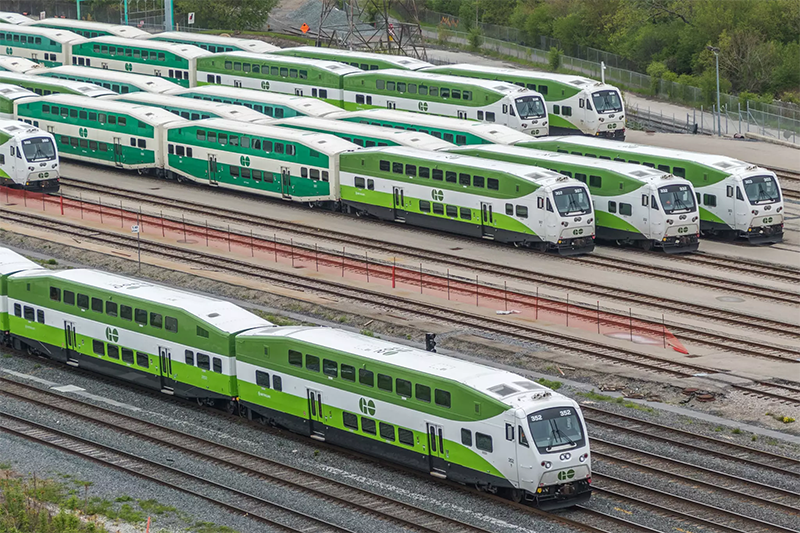Metrolinx is making it faster, easier, and more convenient to travel across the Greater Toronto Hamilton Area (GTHA) with its GO Expansion project.
GO Transit is the GTHA regional transit system consisting of rail and bus services. In its 65-year history, the GO Train network has targeted suburban commuters travelling to and from Downtown Toronto for work. However, this is about to change.
The GO Expansion project will transform the GO Train network into high-frequency transit services with:
- All-day, bi-directional service
- Arrivals and departures every 15 minutes (at least)
- Faster service
- Accessible stations
- More electrified rail lines
Rather than solely serving suburbanites commuting to work, the reimagined system will enable more people to access more destinations more quickly. In many ways, it will operate like a subway service, although the space between each station is wider.
Toronto, London & Paris - a comparison (in scale) of the subway system (blue) and the regional transport system (red) reveals how necessary the recently announced GO Expansion is in Toronto. pic.twitter.com/LSZfr37qNy
— Naama Blonder (@naama_blonder) April 27, 2022

Better Value for Money
The Ontario Line and Eglinton Crosstown LRT have dominated transit news coverage. Despite its transformative nature, the GO Expansion has widely slid under the radar. It also happens to be the most cost-effective ongoing transit project in the GTHA right now.
In 2018, the cost of the GO Expansion was approximately $62 million per kilometre. By comparison, the Ontario Line will cost $720 million per kilometre and the Eglinton Crosstown LRT will cost $660 million per kilometre.
Costs remain relatively low since the project focuses on enhancing existing infrastructure. The work includes adding new tracks to existing corridors, expanding existing stations, and electrifying (some) existing rail lines. It also includes increasing services on existing corridors which currently only operate on a commuting schedule. Provincial and federal of governments are chipping in, including a $1.9 billion dollar commitment from the feds.
Transit-Oriented Communities
At Smart Density, we’re excited for the GO Expansion to revolutionize mobility in the GTHA. Although the project will take a decade to complete, it will spur tremendous opportunities for transit-oriented development (TOD).
TODs concentrate residential, commercial and leisure space around transit stations. Those living and working within a TOD should be able to walk to the transit station and access life’s necessities without needing to get behind the wheel of a car.
As the GO Expansion materializes, TODs can change the face of traditional suburban areas for less car-centric lifestyles.
A TOD wave of growth has already begun along the GO Train network. The Town of Newmarket committed to intensifying the area surrounding a proposed GO station along Mulock Drive. The town solidified their commitment in a new Mulock Station Area Secondary Plan.
Similarly, the Vision Cooksville Report by the City of Mississauga describes long-term planning for the Cooksville community based on planned transit expansion in the area.
Durham Region is home to several GO stations and will see increased service in the coming years. In December 2020, the region published a report outlining policies for growth around Major Transit Station Areas (MTSAs).
Midtown Oakville, home to Oakville GO station, is an urban growth area within the provincial Growth Plan. The Town of Oakville proposed an Official Plan amendment to update growth policies to ensure that the area develops in such a way that is pedestrian-oriented, promotes compact living, and takes advantage of transit investments.
Adding density around transit stations is the right move and municipalities are getting on board. Newmarket, Durham, Cooksville and Oakville are good examples of planning for transit expansion and intensification. This form of development supports a vibrant, walkable lifestyle, capitalizes on public transit investment, demands less from civil infrastructure, accommodates a growing region, and is environmentally responsible.
It’s Time for a Change
Transit was dramatically disrupted during the pandemic.
Travel behaviour shifted as people fled the city in search of backyards and home offices in the suburbs. We learned that a transit system structured around a commuting lifestyle is poorly equipped to serve the mobility needs of diverse riders in a dynamic region.
The GO Expansion project transforms an outdated service model so that more people can reach more destinations across the GTHA.
As public health measures ease and people re-emerge from lives of limited exposure, the GO Expansion will absorb new travel patterns in a post-pandemic society. Cities like Brampton, Oshawa, and other outer areas that accommodated fleeing urbanites will benefit significantly from expanded, comprehensive service.
People who start commuting again will be met with better choices in terms of how and when they travel to and from work. People who return to excitement and entertainment in downtown Toronto will be able to get around more efficiently.
As the GO Expansion project progresses, the region needs to get its suburban planning scheme right in order to capitalize on this transit transformation. The GO Expansion could be the next step in Toronto’s evolution toward becoming a well-connected region like London and Paris.
Monitoring Progress
In April, 2022, Metrolinx and Infrastructure Ontario announced an agreement with ONxpress Transportation Partners (ONxpress) comprised of a consortium of stakeholders who will carry the project from construction all the way through to system operations. The consortium includes international partners with global expertise in transit development and operations.
Learn More
To learn more, check out Smart Density’s GO Expansion Station Profiles and Growth Opportunity by clicking here. To learn more about our work on Transit-Oriented Communities, check out our Oakville GO Master Plan, Bloor-Lansdowne Master Plan or Kennedy Station TOD.
